
Eureka Stockade 1949 Daybill Poster by Frank Tyler
Frank Tyler (artist) Eureka Stockade, 1949 daybill poster, colour lithograph, printed by W.E. Smith Ltd., Sydney, 76 x 34 cm.

Vintage Australian 'Gone with the Wind' Movie Poster, Lithograph
Australian vintage 'Gone with the Wind' movie poster. Pub. Robert Burton Pty Ltd, Sydney, lithograph (101 x 68 cm
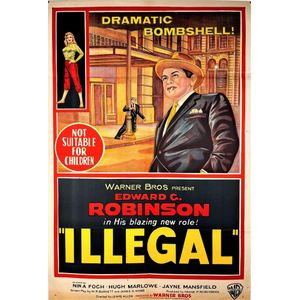
1955 Illegal: Crime Drama with Robinson & Mansfield
Illegal 1955 (Warner Bros.) Starring Edward G Robinson, Jayne Mansfield & Directed by Lewis Allen, one original colour lithographic Australian Movie poster, Produced by Southern Studios & Printed by F. Cunninghame & Co. Sydney, sheet 101 x 69 cm
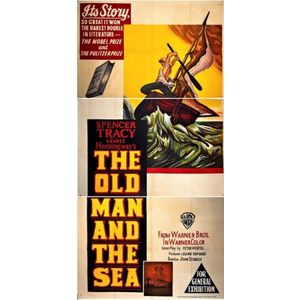
The Old Man & The Sea: 1958 Australian Movie Poster
The Old Man & The Sea 1958 (Warner Bros.) Starring Spencer Tracey, Felipe Pazos & Directed by John Sturges, original colour lithographic Australian Three Sheet Movie poster, Produced by Southern Studios & Printed by F. Cunninghame & Co. Sydney, Overall:…

Moby Dick (1956) Australian Three Sheet Movie Poster
Moby Dick 1956 (Warner Bros.) Starring Gregory Peck, Richard Basehart, Orson Welles & Directed by John Huston, original colour lithographic Australian Three Sheet Movie poster, Produced by Southern Studios & Printed by F. Cunninghame & Co. Sydney, Overall…

The Gorgon Case: 1977 Polish Movie Poster
Sprawa Gorgonowej (The Gorgon Case) 1977 directed by Janusz Majewski, image by Lenica, original colour lithographic Polish Movie poster, sheet 94 x 68 cm
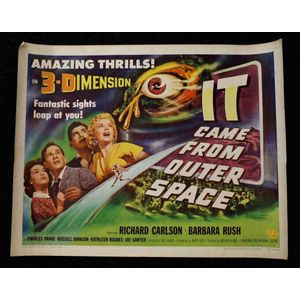
Thrills in 3D: 1953 Original Movie Poster, Chromolithograph (50x65cm)
1953, Original movie poster, Amazing Thrills! in 3-Dimension, Chromolithograph,50 cm x 65 cm
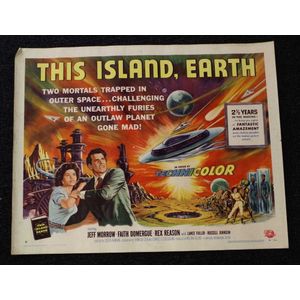
This Island Earth: 1954 Chromolithograph Movie Poster (50cm x 65cm)
1954, Original movie poster This Island Earth, Chromolithograph, 50 cm x 65 cm
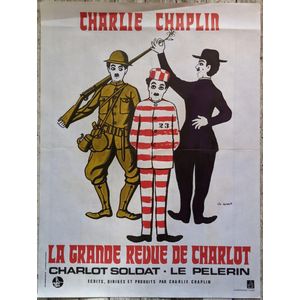
Foreign Language Movie Posters Bundle
La Grande Redue De Charlot 1958, Starring Charlie Chaplin, Svigermors Penge 1970, Starring Mel Brooks & La Roman de Marguerite Gautier 1936, Starring Greta Garbo, three foreign Language movie posters, 80 x 60 cm, 84 x 60 cm, 63 x 48 cm
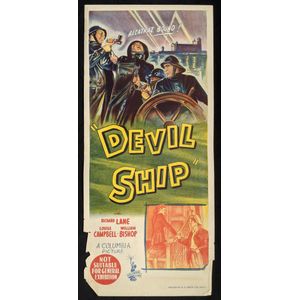
Devil Ship (already provided in the prompt)
Devil Ship 1947, Starring Richard Lane, Louise Campbell & William Bishop, Columbia pictures, original mid 20th century movie poster, Printer: daybill, Printer: W E Smith, Sydney, 34 x 76 cm. Provenance: The turner collection, Adelaide
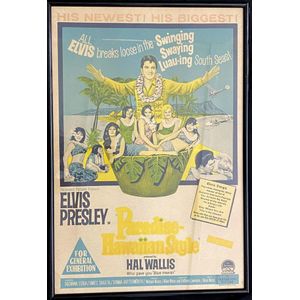
Paradise Hawaiian Style
Paradise Hawaiian Style 1966, Starring Elvis, Suzanna Leigh & Donna Butterworth, Paramount pictures, Director: Michael Moore, Producer: Hal Wallis, original mid 20th century framed movie poster, Printer: Robert Burton Pty Ltd, Sydney, sheet: 101 x 69 cm,…
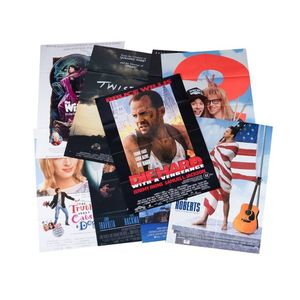
Mainstream Movie Posters 1980-2000
Quantity Mainstream Movie Posters - 40 full sheet posters 1980-2000. Includes Die Hard with a Vengeance, Get Shorty, Waterworld, Twister, Boxing Helena, Wayne's World, 1 & 2, What's Eating Gilbert Grape, True Lies, When We Were Kings. cinema used tape &…
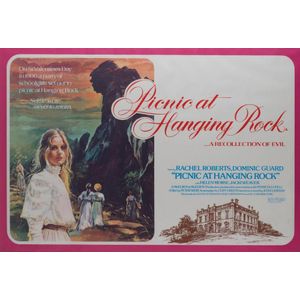
Hanging Rock Picnic
Film Poster: 'Picnic at Hanging Rock', UK poster painted in gouache, by Brian Bysouth, 1975, 75 x 100 cm. (framed & glazed: 83 x 115 cm).
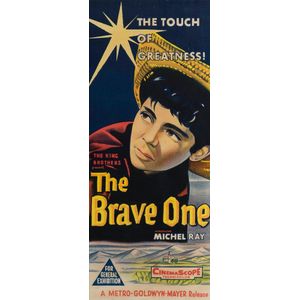
The Brave One
Australian Release Movie Poster: The Brave One, lithographic day-bill, circa 1960, framed & glazed 94 x 51 cm overall
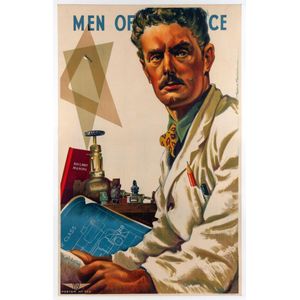
Men of Service - Rare Vintage Locomotive Poster
Harold Emanuel Freedman (1915-1999), Men of Service (the locomotive designer), colour lithographic poster, circa 1947, poster No.248 for Victorian Railways, printed by F.W. Niven. Linen backed, 101 x 64 cm. Extremely rare image.

"Women of Service" Railway Poster by Freedman (1947)
Harold Emanuel Freedman (1915-1999), Women of Service (the porter), colour lithographic poster, circa 1947, poster No.245 for Victorian Railways, printed by F.W. Niven. Linen backed, 101 x 64 cm. The rarest of the images in the series.
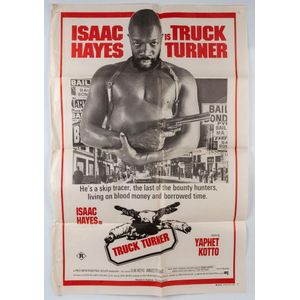
Isaac Hayes Movie Posters: Truck Turner and Tough Guys
Isaac Hayes: two original Australian release one sheet movie posters: truck turner, (1974), and, Tough Guys, (1974); in which he acted and wrote and performed the music. (2).

Australian 1970s Classics Film Posters (3 pieces)
Australian Classics of the 1970s: Alvin purple, 1973 one-sheet poster;, Petersen, 1974 daybill;, the box, 1975 daybill. (3 items).
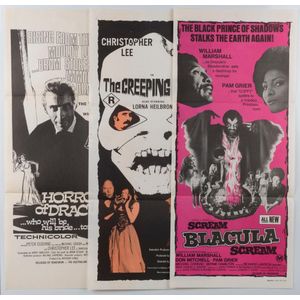
Horror & Fantasy Daybill Posters (1960s-70s) - Australian Printers/Publishers
Horror & Fantasy: 1960s-70s daybill posters, all Australian printers/publishers: the night Evelyn came out of the grave, dark places, Blacula, Scream Blacula Scream, the Creeping Flesh, and, Horror of Dracula, . (6 items).

Waldemar Swierzy Film Posters
Waldemar Swierzy (Polish, 1931 - 2013). Pan Wolodyjowski, film poster. Lithograph in colours, 1969, Druk: 'Prasa' K-ce, zam. 494/69 at lower left, Director: Jerzy Hoffman; Starring: Tadeusz Lomnicki and Henryk Sienkiewicz. 83 x 58 cm. Also, another film…
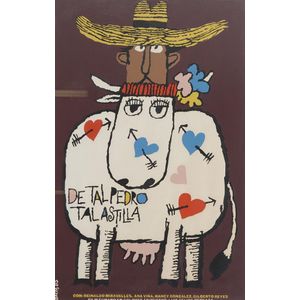
Pedro's Legacy
Vintage Cuban movie poster for 'De tal Pedro tal astilla', 1987. Framed. Height 84.5 cm, width 57.7 cm
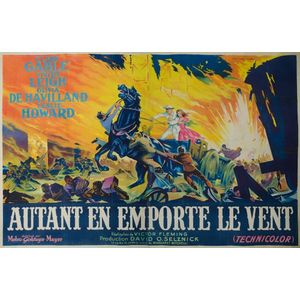
Canvas-backed 'Gone with the Wind' original movie poster
Canvas-backed 'Gone with the Wind' original movie poster. French release 'Autant en Emporte le Vent.' artwork by Roger Soubie 1898-1984). Lithograph 148 x 227 cm
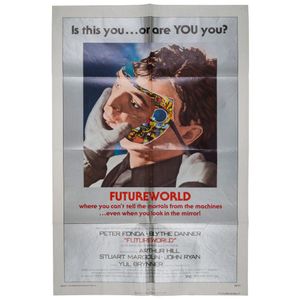
Futureworld: The Future is Now
Movie Poster, 'Futureworld' (1976) original one-sheet poster, 103 x 69 cm (folded, as distributed).
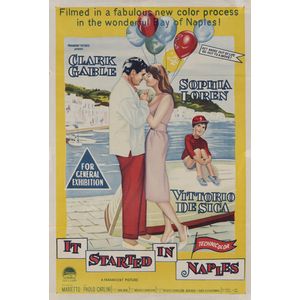
'Naples Affair'
'It Started in Naples' (1960), starring Clark Gable & Sophia Loren, Australian one-sheet movie poster, size 68 x 101 cm. Attractive and scarce.
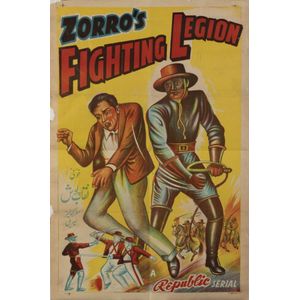
1950s Pakistani Movie Posters: Flash Gordon, Chaplin, Jungle, Zorro
Movie Posters 1950s from Pakistan, noted 'Flash Gordon' (2 different, starring Buster Crabbe, originally issued in 1936); 'The Charlie Chaplin Festival', 'Jungle King' (2 different), 'Jungle Queen' & 'Zorro's Fighting Legion'. Each about 51 x 76 cm,…
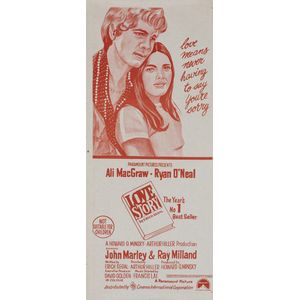
Assorted Australian Movie Posters
Movie posters, noted Australian daybill posters (31) including 'All The President's Men' (1976), 'Jesus Christ Superstar' (1973), 'Love Story' (1970) & 'Billy Jack' (1971); one-sheet posters (7) including 'Papillon' (1973). (Qty 31)
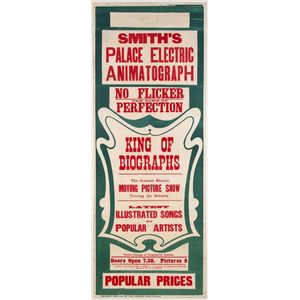
Palace Electric Animatograph Poster
Early Movie Theatre Poster, circa 1907 'No Flicker, The A cme of Perfection. Palace Electric Animatograph. Selwyn Conjuror and Expert Card Manipulator, printed by The Swift Printing Co., Sydney, red text with green surrounds, linen backed. 37 x 95 cm.
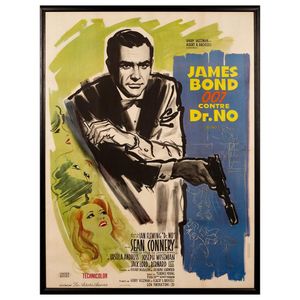
Dr. No French Poster by Boris Grinsson (1962)
James Bond - Dr. No French poster by Boris Grinsson, 1962, Boris Grinsson's striking artwork for the French release of the first James Bond film, Dr. No, prominently highlights Sean Connery as the suave British spy in an evening suit with his trusty…

Dark Crystal: Unleash the Power
Dark crystal; movie poster Provenance: Robbie Buonaccorsi collection 90 x 60 cm

Aussie Film Posters 1949: Murray Valley & Short Subjects
Australian film posters 1949, double-sided; the Murray Valley & short subjects, 55 x 42 cm, unframed.
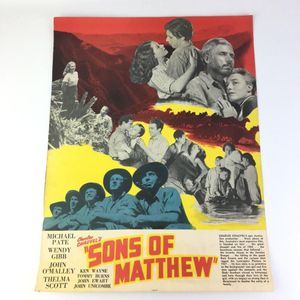
Aussie Film Posters: Sons of Mathew & Into the Straight
Australian film posters 1949, double-sided; Sons of Mathew & into the straight, 55 x 42 cm each, unframed.
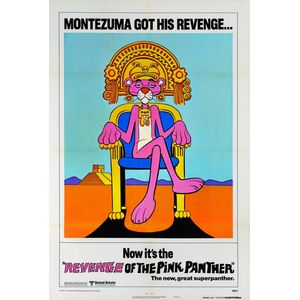
"Revenge of the Pink Panther" Poster, Framed
Revenge of the pink panther poster 1978, advance style B, US, framed
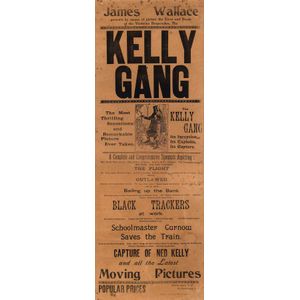
The Kelly Gang: Original 1909 Film Advertising Poster
'The Story of the Kelly Gang' circa 1909 original daybill advertising poster, approx. 78 x 29 cm printed in black on newspaper-quality stock; predominantly text with a vignette view of Ned Kelly wearing his 'helmet' and firing his gun in a forest scene.…
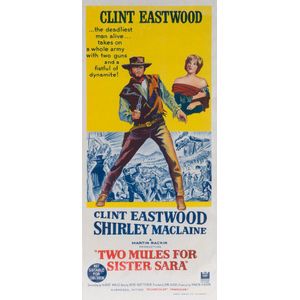
Two Mules, One Man: Eastwood's Explosive Showdown
Movie Poster Two Mules For Sister Sara original 1970 colour lithograph by Robert Burton Pty Ltd., Sydney 'Clint Eastwood...the deadliest man alive...takes on a whole army with two guns and a fistful of dynamite!' 76 x 34 cm
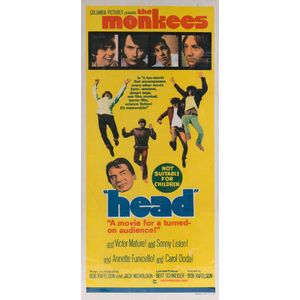
The Monkees: A Genre-Bending Fun-Movie
1970 colour lithograph by M.A.P.S. Litho Pty Ltd Movie Poster 'head' original 1968 colour lithograph by M.A.P.S. Litho Pty Ltd 'Columbia Pictures presents the Monkees in a fun-movie that encompasses every other movie form - western, desert saga, war film,…
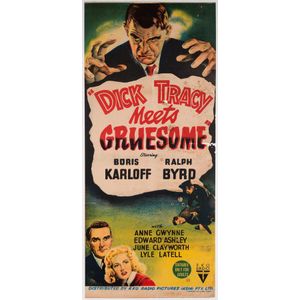
Dick Tracy Meets Gruesome
Movie Poster Dick Tracy Meets Gruesome 1947 colour lithograph, 77 x 33 cm. Linen-backed. 'Starring Boris Karloff, Ralph Byrd..... Suitable for adults only. Distributed by Rko Radio Pictures (A'sia) Pty Ltd. Simmons Ltd Litho. Sydney.' William Henry Pratt…
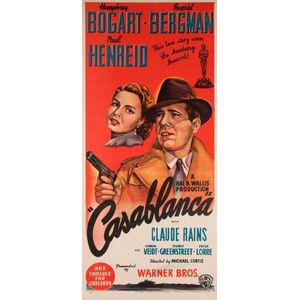
Casablanca: Love in War
Movie Poster Casablanca 1947 colour lithograph, 76.5 x 33.5 cm. Linen-backed. 'Humphrey Bogart, Ingrid Bergman, Paul Henreid. Their love story won the Academy Award! A Hal B. Wallis production? with Claude Rains, and Conrad Veidt, Sydney Greenstreet,…
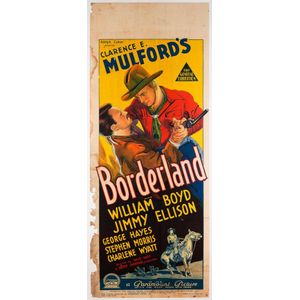
Borderland: Hopalong Cassidy
Movie Poster 'Borderland' (Hopalong Cassidy) 1937 colour lithograph, 103 x 39 cm. Linen-backed. 'Adolph Zukor presents Clarence E. Mumford's Borderland with William Boyd, Jimmy Ellison, George Hayes, Stephen Morris, Charlene Wyatt. Directed by Nate Watt.…
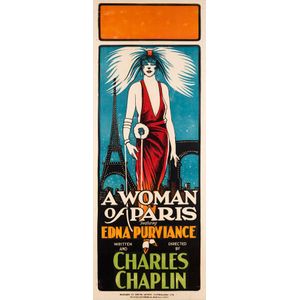
A Woman of Paris: A Drama of Fate
Movie Poster A Woman of Paris 1923 colour linocut with letterpress, 102 x 38 cm. Linen-backed. 'Featuring Edna Purviance. Written and directed by Charles Chaplin.' Released by United Artists (Australasia) Ltd. Jno. Evans & Son Printing Co., 468-488 Kent…

The Siege of Pinchgut
Movie Poster, the Seige of Pinchgut, 1959 Colour lithograph, 77 x 34 cm. Linen-backed., Text includes 'An escaped convict...in his gun-sights a shipload of dynamite...and the city of Sydney! His terms, freedom or annihilation!' Filmed in Australia. An…

Foreign Film Posters from Australia
Movie Posters, A group of four Australian printed one-sheet movie posters for foreign-produced films being distributed in Australia. The posters are for 'The Beloved Cheater' (1919, American, Mutual Films), 'The Last Laugh' (1924, German, Master Pictures)…
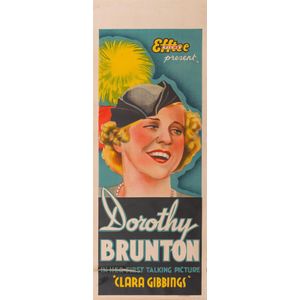
Clara Gibbings Daybill Posters Collection (1934)
A collection of 'Clara Gibbings' daybill posters, C 1934

McDouall Stuart: Northern Territory's Adventurer
Film Poster: 'Inland with McDouall Stuart - A man of Stamina' [1956, lithograph in colours, William Brooks & Co., Sydney]. The film, a documentary about Stuart and about the Northern Territory, was made by Australian Instructional Fims, Sydney. 73 x 97 cm…

Vintage Movie Posters: 2001 & 20,000 Leagues Under the Sea
Circa 1960s movie day bill posters '2001: a Space Odyssey' and '20,000 Leagues Under the Sea' by Robert Burton (Sydney), 75 cm x 33 cm
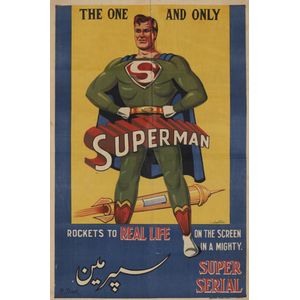
The One and Only Superman
India: Superman: 1950 (circa) 'the One and Only Superman' poster of Superman in non-traditional colours & a rocket (51 x 76 cm) by Karachi Herald for early-1950 S release of 15-part serial that starred Kirk Alyn as Superman and Noel Neill as Lois Lane.

Man Who Fell: Vintage Bowie Movie Poster (1976)
David Bowie, The Man Who Fell to earth, vintage UK quad movie poster, 1976, 75.5 cm x 100.5 cm

007 Returns: Original 1969 Poster in Framed Display
On her Majesty's service, James Bond 007 is back, 1969, original movie poster, orignal creasing, framed 95 x 61 cm
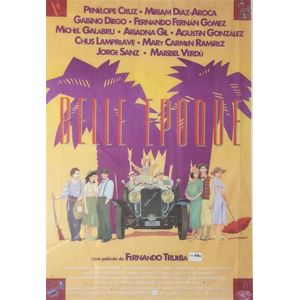
Belle Epoque: French Silkscreen Movie Poster (1992)
A Belle Epoque 1992 movie poster, French Version, silkscreen, framed 96.5 x 66 cm

1981 Raiders of the Lost Ark Australian Daybill Poster
A 1981 Raiders of the lost Ark Australian original daybill poster, stored flat, has two fold creases as issued, 34 x 68 cm

Bikini Beach
Original Movie Poster, 'Bikini Beach,' 1964. Paramount. Pub. W Schey Poster Co, 102 x 68 cm
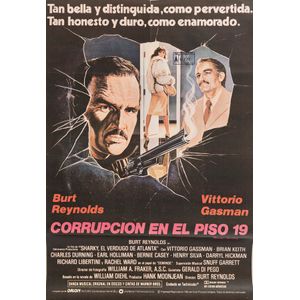
Vintage European Movie Posters Collection
A collection of vintage European movie posters, 90 cm high, 70 cm wide
![[movie poster, French] Bullit, Steve McQueen, Robert Vaughan,…](https://img.carters.com.au/300x300/83c6845dc6366cb66cc5e31199952b22.jpg)
Bullit: McQueen's Iconic Thriller
[movie poster, French] Bullit, Steve McQueen, Robert Vaughan, Jacqueline Bisset, une Solar production, poster, 85.5 x 59 cm
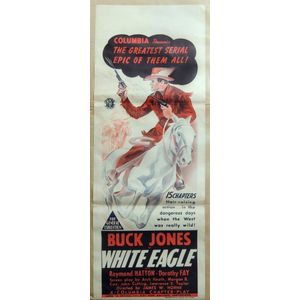
Buck Jones in White Eagle
Buck Jones white eagle movie poster. Australian release long daybill from 1941. Two folds (as issued), with puncture tear to bottom fold. 38 x 102 cm

Farewell Pork Pie
Movie poster 'Goodbye Pork pie' 1981, Laid down on hardboard (water stain). Dimensions 88 cm x 7 cm.
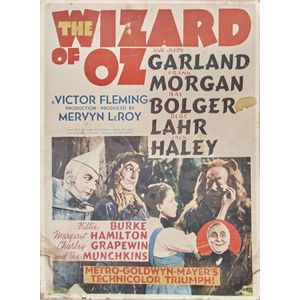
Vintage 'Wizard of Oz' Movie Poster on Thick Cardboard
An original 'Wizard of Oz' movie poster, 1939 starring the young Judy Garland, laid down on thick cardboard. Dimensions 60 cm x 3 cm.

Strike Me Lucky
c1934 movie poster, 'Strike Me Lucky' (1934) starring Mo (Roy Rene), directed by Ken G. Hall, photographed by Frank Hurley, colour lithograph printed by W. E. Smith Sydney, framed & glazed, overall 85 x 105 cm

Vintage Film Posters: Chariots & Black Emmanuelle
Two vintage movie posters, Chariots of fire and black Emmanuelle
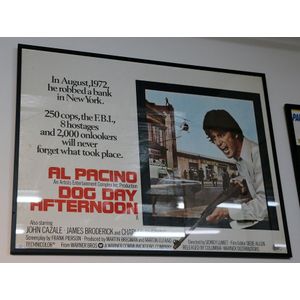
Pacino's Vintage Dog Day Afternoon Poster
Al Pacino dog day, afternoon, vintage movie poster. 75 x 100 cm
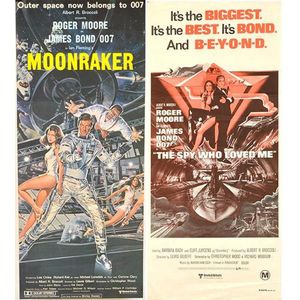
James Bond Daybill Posters
Two Australian daybill posters, including 'Moonraker' (1979) and 'The Spy Who Loved Me' (1977) (2)
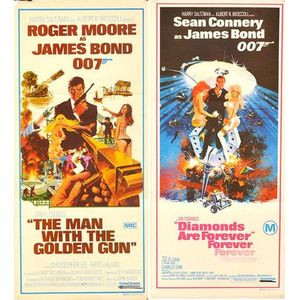
Australian Bond Posters: Golden Gun & Diamonds Forever
Two Australian daybill posters, including 'The man with the golden gun' & 'Diamonds Are Forever' (2)

Australian Film Posters: Jedda and Age of Consent
Two Australian one sheet film posters, including 'Jedda' (1955) fully folded; and 'Age of Consent' (1969) (2)

Classic Film Posters Collection
Six daybill film posters, including 'Taxi Driver' (1976); 'Ben Hur' (1959); 'The Day the Earth Stood Still' (1951); 'Salon Kitty' (1976); 'The Creature with the Atom Brain' (1955); and 'The King of Comedy' (1982) (6)

Retro Film Posters Collection
Six one sheet film posters, including 'The Goonies' (1985); 'The Fly' (1986); 'The Colour Purple' (1985); 'Christine' (1983); 'Jaws Ii' (1975); and 'Who Framed Roger Rabbit' (1989) (6)
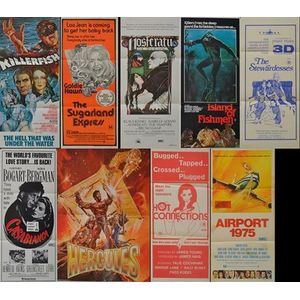
13 Vintage Film Posters
Thirteen daybill film posters, including 'Nosferatu' (1978); 'Sugarland Express' (1974); 'Airport' (1975); 'Killer Fish' (1979); two 'The Stewardess' (1969); four 'Hot Connection' (1973); 'Island Fishmen' (1979); 'Hercules' (1958); and 'Casablanca' (1942)…
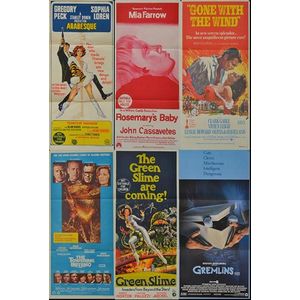
Australian Film Posters: Rosemary's Baby, The Green Slim, Towering Inferno, Gone with the Wind
Four Australian daybill film posters, including 'Rosemary's Baby' (1968); 'The Green Slim' (1968); 'Towering Inferno' (1974); and 'Gone with the Wind' (1974 Reprint), all fully folded (4)

Ten Classic Film Posters
Ten daybill film posters, including 'The Thing' (1982); 'Escape From New York ' (1981); 'Halloween' (1978); 'Halloween Ii' (1981); 'Dark Star' (1974); 'The Philadelphia Experiment' (1984); 'Assault on Precinct 13' (1976); 'Breaker Morant' (1980);…
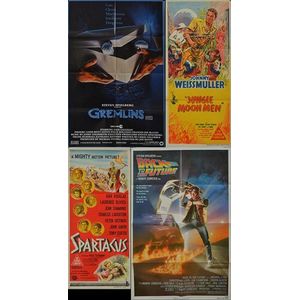
Folded Film Posters: Back to Future, Gremlins, Spartacus, Jungle Moon Men
Two one sheet film posters, including 'Back to the Future' (1985); 'Gremlins' (1984); and two Australian Daybills, including 'Spartacus' (1960); and 'Jungle Moon Men' (1955), all fully folded (4)

1959 Australian film poster: 'The Bat'
'The Bat' (1959) Australian daybill film poster, fully folded
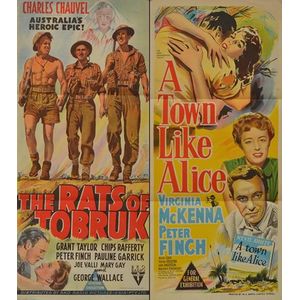
Alice & Tobruk: Australian Film Posters (1956-1944)
Two Australian daybill posters, including 'A Town Like Alice' (1956) and 'Rats of Tobruk' (1944), both fully folded (2)
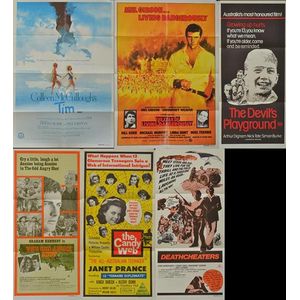
Australian Film Posters - Tim, Dangerously, Angry Shot, Candy, Playground, Cheaters
Two one sheet film posters, including 'Tim' (1979); 'The Year of Living Dangerously' (1982); and four Australian Daybills, including 'The Odd Angry Shot' (1979); 'The Candy Web' (1963); 'The Devil's Playground' (1976); and 'Death Cheaters' (1976), all…

'On Our Selection' Film Poster
'On Our Selection' (1932) Austrailan daybill film poster, fully folded
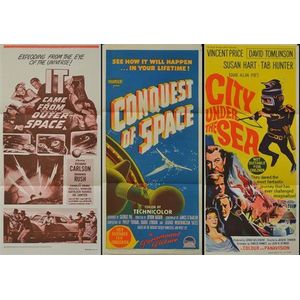
Australian Film Posters (1953-1965)
Three Australian daybill film posters, including 'It Came From Outer Space' (1953); 'Conquest of Space' (1955); and 'City Under the Sea' (1965), all fully folded (3)

The Overlanders
Movie Poster: 'The Overlanders' original release colour lithograph daybill printed by W. E. Smith ltd. Sydney;76 x 34 cm, laid down on linen.
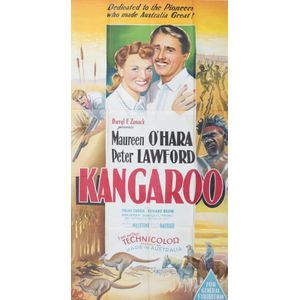
Kangaroo Adventure
Movie Poster: c. 1952 'Kangaroo' Australian 3 sheet movie colour lithograph poster, artwork by Zeck, 20th century Fox;104 x 203 cm (overall size).
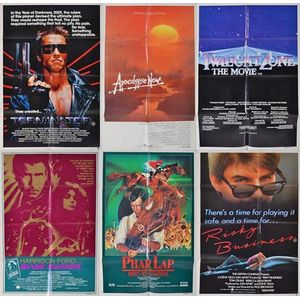
Film Poster Package
Package of film posters, including 'The Terminator' (1984), 'Apocalypse Now' (1979), 'Risky Business' (1983) 'The Twilight Zone' (1983), 'Phar Lap' (1983) and 'Blade Runner' (1982), all fully folded (VG) (6)
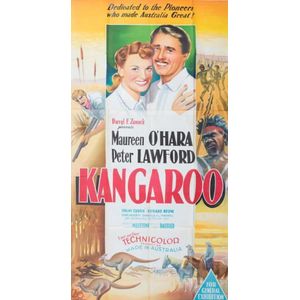
Kangaroo: The Outback Adventure
Movie Poster: c. 1952 'Kangaroo' Australian 3 sheet movie colour lithograph poster, artwork by Zeck, 20th century Fox; 104 x 203 cm (overall size).
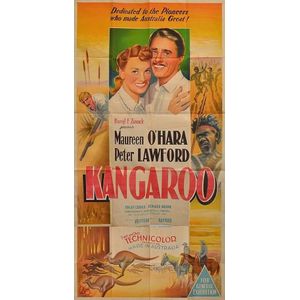
Kangaroo: 1951 Australian Movie Poster
Kangaroo (20th century fox, 1951) Australian three sheet movie poster. In three panels, folded, some stains and minor loss, good to very goodApproximately 206 x 102 cm
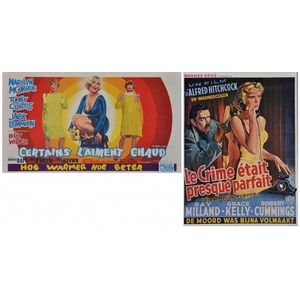
Belgium Movie Posters: Dail M, Certains Laiment Chaud (2)
Two framed Belgium movie posters, including 'Le Crime Etait Presque Parfait' (Dail M for Murder) and ' Certains Laiment Chaud' (some like It hot), A/F, printed later (2)

Coca-Cola Refreshes in Vintage Advertising Poster
A Coca-Cola 'Refreshing' advertising poster, c.1949; colour lithograph, linen backed. 50 x 91.2 cm. Provenance: Joseph Lebovic gallery 1999

Film Posters: Trainspotting & Once Were Warriors
Trainspotting (Channel Four Films, 1996) U.K. one sheet poster, and a one sheet poster for 'Once were Warriors' signed by stars Rena Owen and Temuera Morisson, good to very good (2) Trainspotting 102 x 68 cm
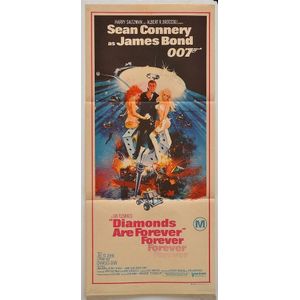
Diamonds Forever
Diamonds Are Forever (United artists, 1971) Australian daybill movie poster. Very good to fine 76 x 34 cm
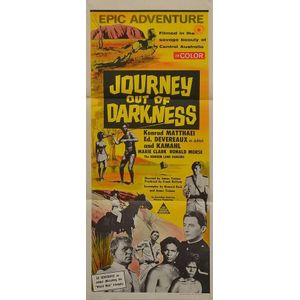
Darkness Journey
Journey Out of Darkness (Australian-American Pictures, 1967). And 'Demonstrator', (Freeman-Fishburn international, 1971), Australian daybill poster, both folded, very good to fine (2) both 76 x 34 cm

The Graduate: Two Posters
Two movie posters for the Graduate (United artists, 1968), including one Australian one sheet and one Australian daybill, good to very good (2) largest 104 x 68 cm
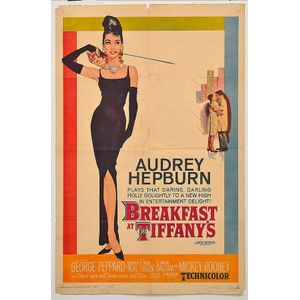
"Breakfast at Tiffany's" U.S. One Sheet Poster
A Breakfast At Tiffany's (Paramount, 1961) U.S. one sheet poster, folded, good to very good 104 x 68 cm
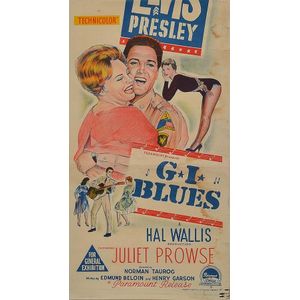
Elvis Presley Movie Posters (1960-1969)
Three Elvis Presley movie posters, including Speedway (MGM, 1968) Australian one sheet poster; change of Habit (MGM, 1969), Australian daybill; and G.I. Blues (MGM, 1960), Australian daybill, top edge cropped, poor to good (3) largest 69 x 104 cm

Australian Carry On Movie Daybill Posters (4)
Four Australian daybill posters for Carry on Movies, including 'Carry on Henry' (rank, 1971); 'Carry on cowboy' (Peter Rogers Productions, 1965); and 2 x 'Carry on Again Doctor' (rank, 1969), all folded, very good to fine (4)

Jedda: Uncivilized
Jedda the Uncivilized (Dca, 1956) U.S. one sheet movie poster. Style A, tape repairs to fold lines, good 103 x 68 cm
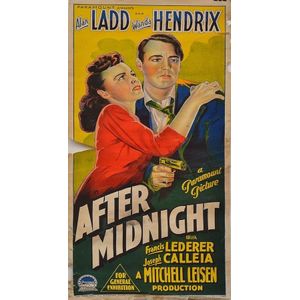
Australian Daybill Movie Posters Collection
Sixteen Australian daybill movie posters, comprising 5 Rko films 'Tarzan's Peril' (1951), 3 copies; 'The Bells of St Mary's' (1946); and 'The twisted road' (1948); and 11 others by Richardson Studios including 'Forever female' (Paramount, 1953), 2 copies;…
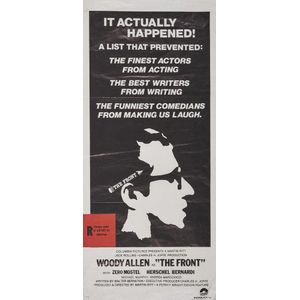




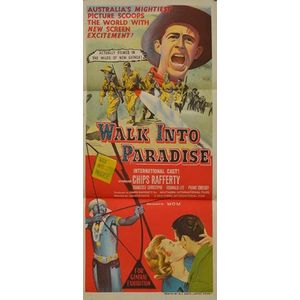


 Loading more...
Loading more...